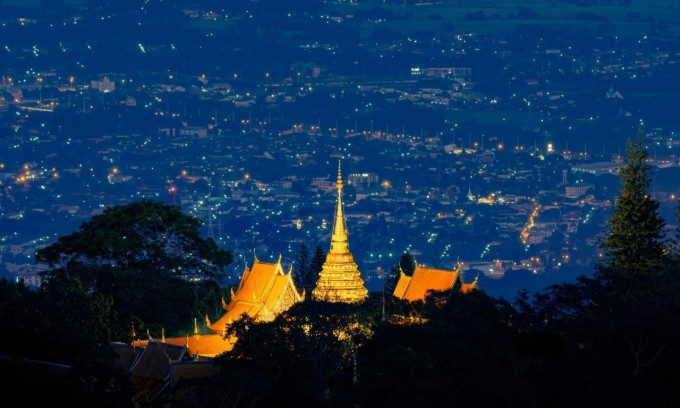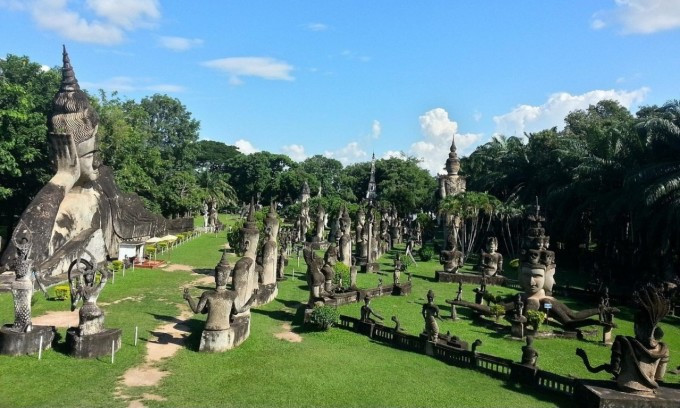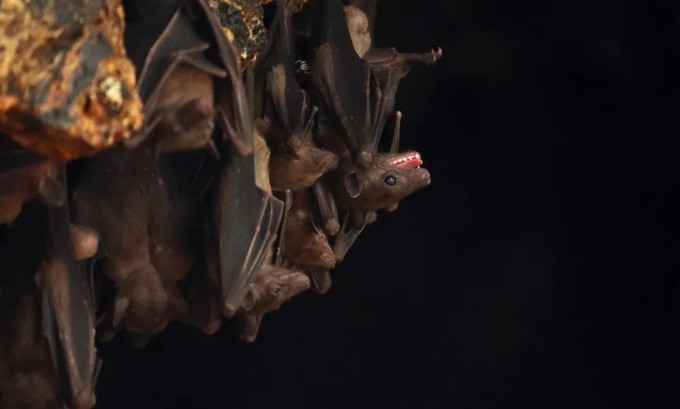Stories about spirits and monsters at some tourist destinations in Asia are said to be scarier than Halloween scares.
Halloween has become a glamorous and less scary festival. When people think of the holiday at the end of October, they often think of costume parties and trick-or-treating, with ghosts and demons seemingly just "side characters".
In Asia, there are places rumored to be “haunted”, making visitors shiver as soon as they step foot in them. The stories about these places are much scarier than Halloween festivals, which are gradually becoming more entertaining and frightening. Below are 5 destinations listed by Hong Kong newspaper SCMP.
Doi Suthep, Chiang Mai, Thailand
Chiang Mai's famous Doi Suthep Hill in northern Thailand is a popular tourist attraction with hiking trails, lush gardens and gilded temples. It is considered sacred by locals.

A temple in Doi Suthep lights up at night (Photo:Getty)
According to the legend of the Lawa people of Northern Thailand, a local couple secretly followed the Buddha and intended to eat him. Afterwards, the two criminals were bewitched and turned into ghosts wandering forever on this Doi Suthep hill.
This hill area also has a temple that holds horrifying exorcism rituals. The person performing the ritual must perform the ritual of drinking alcohol, drinking buffalo blood and speaking an ancient language.
According to locals, this ritual usually takes place in June, to appease the spirits of two giant monsters, which are said to have eaten people. This ritual is believed to have originated from the Lawa people who lived in Chiang Mai 1,500 years ago.
Feroz Shah Kotla Fort, New Delhi, India
Local legend has it that the 14th-century Feroz Shah Kotla fort is inhabited by shape-shifting spirits known as jinn.
In Arab lore, jinn are said to curse Muslims. These supernatural creatures can take human, animal, or invisible forms. In 1350, the Feroz Shah Kotla fortress was built for a Muslim king, and since then the place has been "haunted" by Jinn.
Today, many tourists visit the complex to admire the remaining ruined architecture, while some come to pray to the Jinn by writing letters or talismans.
Buddha Park, Vientiane, Laos
This sacred garden is located in the quiet southern suburbs of Vientiane.
Legend has it that Xieng Khuong Garden contains hints explaining the strange philosophy of sculptor Bunleua Sulilat (1932-1996), who created the Buddha garden. When completed, the garden was named "city of souls".
The owner of the Buddha statues here is not just a "sculpting wizard", Bunleua Sulilat once founded his own religion by combining Buddhism, Hinduism and shamanism, attracting a large number of followers in the 1970s.

Buddha statue in Xieng Khuong garden (Photo:TripAdvisor)
The garden is mysterious because it does not have a main hall to worship Buddha, but has more than 200 Buddhist-themed statues with many different styles, different from the statues placed in the usual Buddhist temples.
The grounds of this mysterious place also have a three-story structure representing "heaven", "earth" and "hell". The statues on the hell floor exude a creepy aura, depicting scenes of torture and punishment.
Oiwa Inari Shrine Tamiya Jinja, Japan
This Shinto shrine is said to be home to one of Japan's most famous ghosts, Oiwa. The story surrounding her death has intrigued many visitors.
Oiwa is a character from an ancient folk tale called Yotsuya Kaidan. The story tells of Oiwa’s unjust death, her husband murdered her to marry another woman. Oiwa became a wandering ghost in the house, haunting her ex-husband and cursing his entire family. This shrine was built to appease Oiwa’s vengeful spirit.
The story has been adapted into feature films, television series and animations across Japan. Oiwa's image was the inspiration for the long-haired female ghost character in the globally famous American film "The Ring".
Goa Lawah Temple, Bali, Indonesia
When approaching Pura Goa Lawah temple, many tourists are "terrified" by the cries of thousands of bats hanging from the cave roof.
Legend has it that the bats were "snack" for a giant snake named Naga Basuki who lived in the cave.

Bats hang in a cave near Goa Lawah temple (Photo:Rose Kasil Photography)
Legend has it that the snake lies deep in this cave, stretching all the way to Bali’s mother temple, Besakih Temple, about 20 kilometers to the north. Pura Goa Lawah is both a sacred site for the Balinese and a tourist attraction thanks to the sight of thousands of snakes hanging in the cave near the temple.
Oweynagat Cave, Roscommon, Ireland
According to legend, Halloween originated in Ireland, at Oweynagat Cave in Roscommon town, about 2,000 years ago. According to Irish legend, Oweynagat Cave is the gate between the mortal world and Tir na nog - the dwelling place of gods and demons.
Guided tours are available at Oweynagat. The cave is also part of the submerged ruins of Rathcroghan, the largest unexcavated royal capital in Europe. Every November 1, pagans come to Oweynagat to celebrate Samhain, the Celtic and Scottish New Year.
In the 1800s, Irish immigrants to America brought with them the celebration of Samhain, which is what Halloween is today.
According to VnExpress